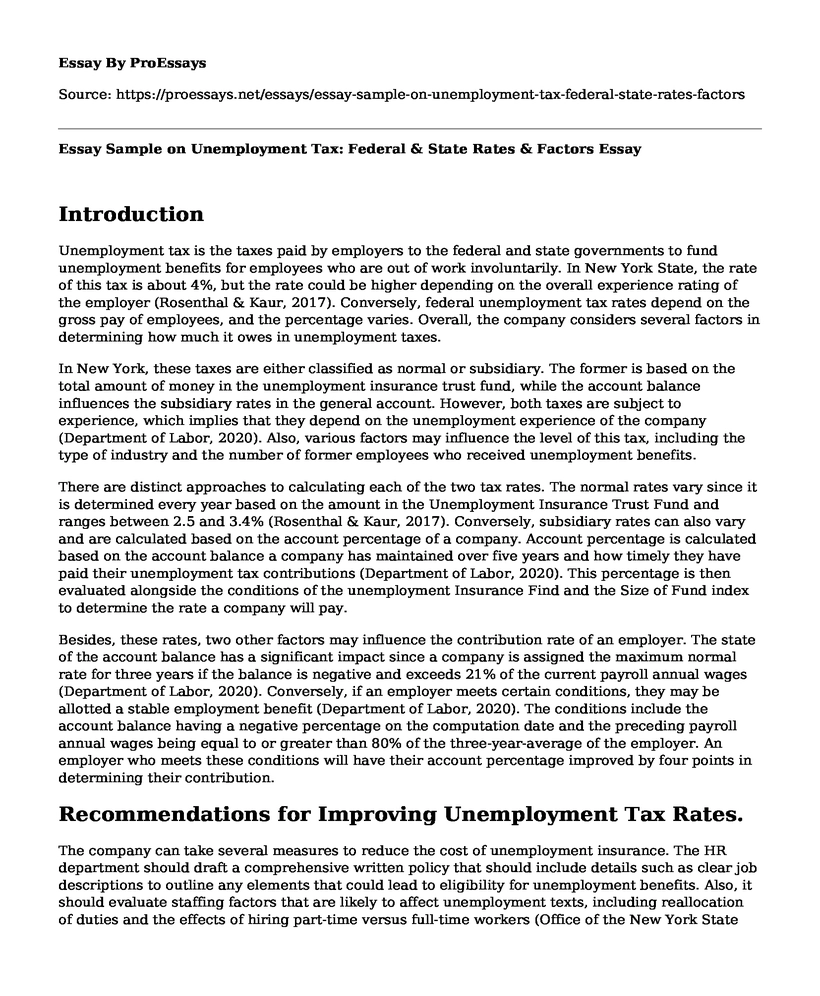Introduction
Unemployment tax is the taxes paid by employers to the federal and state governments to fund unemployment benefits for employees who are out of work involuntarily. In New York State, the rate of this tax is about 4%, but the rate could be higher depending on the overall experience rating of the employer (Rosenthal & Kaur, 2017). Conversely, federal unemployment tax rates depend on the gross pay of employees, and the percentage varies. Overall, the company considers several factors in determining how much it owes in unemployment taxes.
In New York, these taxes are either classified as normal or subsidiary. The former is based on the total amount of money in the unemployment insurance trust fund, while the account balance influences the subsidiary rates in the general account. However, both taxes are subject to experience, which implies that they depend on the unemployment experience of the company (Department of Labor, 2020). Also, various factors may influence the level of this tax, including the type of industry and the number of former employees who received unemployment benefits.
There are distinct approaches to calculating each of the two tax rates. The normal rates vary since it is determined every year based on the amount in the Unemployment Insurance Trust Fund and ranges between 2.5 and 3.4% (Rosenthal & Kaur, 2017). Conversely, subsidiary rates can also vary and are calculated based on the account percentage of a company. Account percentage is calculated based on the account balance a company has maintained over five years and how timely they have paid their unemployment tax contributions (Department of Labor, 2020). This percentage is then evaluated alongside the conditions of the unemployment Insurance Find and the Size of Fund index to determine the rate a company will pay.
Besides, these rates, two other factors may influence the contribution rate of an employer. The state of the account balance has a significant impact since a company is assigned the maximum normal rate for three years if the balance is negative and exceeds 21% of the current payroll annual wages (Department of Labor, 2020). Conversely, if an employer meets certain conditions, they may be allotted a stable employment benefit (Department of Labor, 2020). The conditions include the account balance having a negative percentage on the computation date and the preceding payroll annual wages being equal to or greater than 80% of the three-year-average of the employer. An employer who meets these conditions will have their account percentage improved by four points in determining their contribution.
Recommendations for Improving Unemployment Tax Rates.
The company can take several measures to reduce the cost of unemployment insurance. The HR department should draft a comprehensive written policy that should include details such as clear job descriptions to outline any elements that could lead to eligibility for unemployment benefits. Also, it should evaluate staffing factors that are likely to affect unemployment texts, including reallocation of duties and the effects of hiring part-time versus full-time workers (Office of the New York State Comptroller. n.d.). With such a policy, the company can establish likely layoff costs and get ample information to determine the suitable funding option for unemployment insurance.
Besides, the HR should carefully review claims for propriety after laying off an employee and filing for unemployment insurance. Reviewing notices from the department of labor completely and quickly will enable the company to comment comprehensively, specifying the circumstances that led to unemployment (Office of the New York State Comptroller. n.d.). Such an approach will ensure that no claims are charged to the company's account, which could have increased its tax rates. As such, careful documentation of reviews and records about employees can help cut these expenses. The two approaches will help the firm cut down the current tax rates.
References
Department of Labor. (2020). Calculating an Employer's UI Contribution RateNew York State Department of Labor. New York State, Department of Labor. https://www.labor.ny.gov/ui/bpta/ui-rate-calculation.shtm.
Office of the New York State Comptroller. (n.d.). Office of the New York State Comptroller: Local Government and School Accountability - Cost-Saving Ideas: Minimizing Unemployment Insurance Costs. Office of the New York State Comptroller - Thomas P. DiNapoli : Home. https://www.osc.state.ny.us/localgov/costsavings/unemployment.htm.
Rosenthal, C. L., & Kaur, A. (2017). New York State Department of Labor Unemployment Insurance Tax Audits: A Growing Trend. The CPA Journal, 87(8), 62-63.
Cite this page
Essay Sample on Unemployment Tax: Federal & State Rates & Factors. (2023, Apr 10). Retrieved from https://proessays.net/essays/essay-sample-on-unemployment-tax-federal-state-rates-factors
If you are the original author of this essay and no longer wish to have it published on the ProEssays website, please click below to request its removal:
- Analysis of the Financial Position of Nike Inc.
- Financial Issues in Schools Essay Example
- Performance Measures of Diageo Business Paper Example
- Essay Sample on Banking System Resilience
- Research Paper on Globalization: A Historical Perspective
- Essay Example on Investing in Stocks: Benefits and Risks of Financial Gains
- Essay Sample on Financial Instability: A Growing Challenge for College Students







